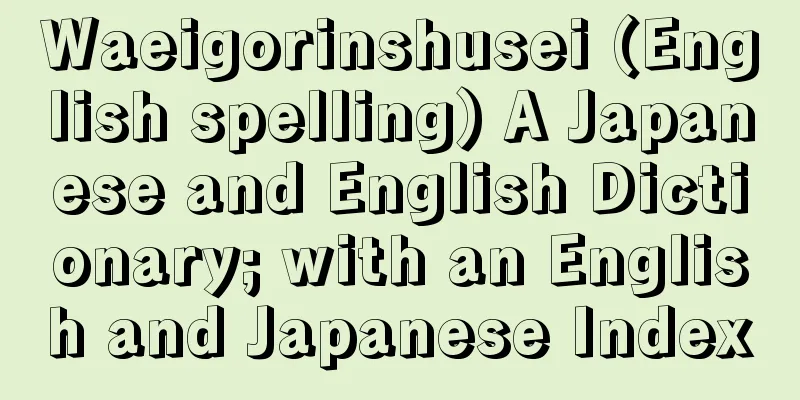Waeigorinshusei (English spelling) A Japanese and English Dictionary; with an English and Japanese Index

|
This was Japan's first Japanese-English dictionary, compiled by the American missionary doctor Hepburn. It has an "English-Japanese section" at the end. Since his arrival in Japan in 1859 (Ansei 6), Hepburn compiled everyday words from all walks of life collected during his medical activities, as well as written words learned from documents such as the "Nippon-Portuguese Dictionary," with the aim of helping future missionaries study the Japanese language and translating the Bible into Japanese. Printed in Shanghai in 1866 (Keio 2), the first edition published the following year in 1867 was extremely well received by Japanese people, and Hepburn himself revised and augmented it until it was reprinted in 1872 (Meiji 5) (the Roman title was changed to A Japanese-English and English-Japanese Dictionary ) and the third edition in 1886 (the Japanese title was changed to "Revised and Supplemented Japanese-English-Japanese Linguistics"). Even after leaving Hepburn's hands, it continued to be published until the ninth edition in 1910 (Meiji 43), and abridged and reprinted versions were also published. The core of the dictionary, Part 1, "Japanese-English section," provides detailed descriptions of Japanese meanings and usage for foreigners, and is said to be the forerunner of modern Japanese dictionaries such as "Genkai." The number of entries was also greatly increased, from 20,000 in the first edition to 23,000 in the second edition and 35,000 in the third edition, reflecting the increase in Japanese vocabulary for Western things and concepts. Part 2, "English-Japanese section," was written in a hurry during the printing of the first edition in order to list Japanese synonyms for English words, and in the first edition it was positioned as an " Index ," but in the second edition, parts of speech were indicated and the title was changed to " Dictionary ." The number of entries in this edition is not as large as that of the "Japanese-English section" - 10,000 in the first edition, 14,000 in the second edition, and 16,000 in the third edition - but there are significant differences in the translations. The first edition replaced English with everyday Edo words, and the second edition featured phrases explaining words without standard translations, but the third edition adopted many new translations that were created in the early Meiji period, some of which were ahead of English-Japanese dictionaries written by Japanese people. There are many examples of words that are not in the "Japanese-English section" that appear in the "English-Japanese section," so this is positioned as a Japanese vocabulary resource that supplements the "Japanese-English section." The romanization used also differs from edition to edition, and the spelling adopted at the request of the Romanization Society during the editing of the third edition became widespread as the so-called "Hepburn romanization." Reprints of the first edition, second edition, and third edition have been published by Hokushin, Toyo Bunko, and Kodansha Academic Library, respectively, and are used as indispensable basic materials for modern Japanese language research. [Satoru Kikuchi February 16, 2018] "The Establishment of Modern Language: Vocabulary of the Meiji Period" edited by Morioka Kenji (1969, Meiji Shoin)" ▽ "Hepburn's Life and the Japanese Language" by Mochizuki Yoko (1987, Shinchosha)" ▽ "Tobita Yoshifumi and Kikuchi Satoru co-edited, "Comprehensive Index of Translations of the First Edition of the Wagai-Rinshu" (1996, Kasama Shoin)" ▽ "Yamaguchi Yutaka edited, "Comprehensive Index of Translations of the Third Edition of the Wagai-Rinshu" (1997, Musashino Shoin)" ▽ "Tobita Yoshifumi and Lee Han-sub edited, "Comprehensive Index of the First, Second and Third Editions of Hepburn's Wagai-Rinshu" 3 volumes in total (2000-2001, Minato no Hito)" [References] | | |Source: Shogakukan Encyclopedia Nipponica About Encyclopedia Nipponica Information | Legend |
|
アメリカ人宣教医のヘボンが編纂(へんさん)した、日本で最初の「和英辞典」。後半に「英和の部」がつく。1859年(安政6)の来日以来、医療活動を通じて採集したあらゆる階層の日常語と、『日葡(にっぽ)辞書』など文献から学習した文章語を、これから来日する宣教師の日本語学習のため、将来の聖書和訳のためにと、集大成したものである。1866年(慶応2)に上海(シャンハイ)で印刷、翌1867年発行された初版が日本人からも非常な好評を博し、1872年(明治5)の再版(欧文名をA Japanese-English and English-Japanese Dictionaryに改題)、1886年の3版(和文名を『改正増補 和英英和語林集成』に改題)まで、ヘボン自身による改訂増補が行われた。ヘボンの手を離れて以後も、1910年(明治43)の9版に至るまで刊行が続き、縮約版、翻刻版も出版された。中核である第1部「和英の部」は、外国人のために日本語の意味、用法を詳しく記述したもので、『言海』など近代的国語辞典の先駆けといわれる。また、見出し語数は、初版が2万語、再版が2万3000語、3版が3万5000語と大きく増補され、西洋からの事物、概念を表す日本語語彙(ごい)が増大したことを反映している。第2部「英和の部」は、初版の印刷中に英単語に対する日本語の同義語を掲出する目的で急きょ書き上げられ、初版では「Index」という位置づけだったが、再版からは品詞表示も施され、表題も「Dictionary」と改められた。こちらの見出し語数は、初版が1万語、再版が1万4000語、3版が1万6000語と「和英の部」ほどの増補ではないが、訳語の異同は著しく、初版では英語を江戸の日常語に置き換え、再版では定訳のない語を句で説明したものが目だったが、3版では明治前期に生まれた新しい訳語が多数採用され、日本人による英和辞書に先駆けているものもある。「和英の部」にない語彙が「英和の部」にみられる例も多く、「和英の部」を補う日本語語彙資料として位置づけられる。使用しているローマ字表記も版ごとに異なり、3版編集時に羅馬字会(ろーまじかい)からの要請で採用した綴(つづり)方が、いわゆる「ヘボン式ローマ字」として普及した。初版、再版、3版は、それぞれ北辰、東洋文庫、講談社学術文庫から復刻版が出され、近代日本語研究に欠かせない基本資料として利用されている。 [菊地 悟 2018年2月16日] 『森岡健二編著『近代語の成立 明治期語彙編』(1969・明治書院)』▽『望月洋子著『ヘボンの生涯と日本語』(1987・新潮社)』▽『飛田良文・菊地悟共編『和英語林集成初版訳語総索引』(1996・笠間書院)』▽『山口豊編『和英語林集成第三版訳語総索引』(1997・武蔵野書院)』▽『飛田良文・李漢燮編『ヘボン著和英語林集成 初版・再版・三版対照総索引』全3巻(2000~2001・港の人)』 [参照項目] | | |出典 小学館 日本大百科全書(ニッポニカ)日本大百科全書(ニッポニカ)について 情報 | 凡例 |
Recommend
Isaiah Bendasan - Izaya Bendasan
...Especially in the field of art criticism, anon...
Wada Pass - Wada Pass
A pass on the old Nakasendo road, located in the n...
Aristolochia
A vine of the Aristolochiaceae family with around ...
Three-faced babysitter - Mitsumen no Komori
The title of a Kabuki dance piece. Tokiwazu. The o...
Fichte - Johann Gottlieb Fichte
A philosopher who founded German idealism. [Mamor...
Cotyledon
…The subfamily Cotyledoninae is found mainly in s...
Erythema nodosum - Erythema nodosum
What is the disease? Lower leg ( Hard ) It is a d...
Kagawa Irrigation Canal
This irrigation canal directs water from Sameura D...
Saprophagy
…Plants that cannot synthesize enough nutrients t...
Operating Leverage
Financial leverage is the use of liabilities that...
Li Qingzhao
A female lyricist in the Song dynasty of China. H...
Mr. Ido
…The Toyoda clan rose to prominence during the Na...
Klossowski de Rola, B.
…French painter. His real name was Balthasar Klos...
Amsar - Amsar
…the name of the military towns built in the conq...
Gomukha
...From around the 8th century, Yakshas (demon de...



![Aso Uchinomaki [Hot Springs] - Aso Uchinomaki](/upload/images/67cad4a20aec8.webp)





